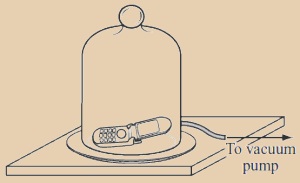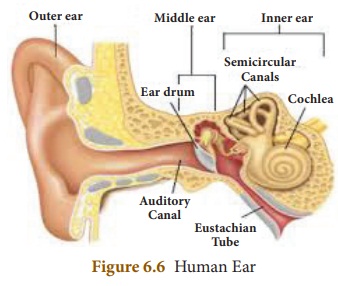Sound | Chapter 6 | 8th Science - Questions Answers | 8th Science : Chapter 6 : Sound
Chapter: 8th Science : Chapter 6 : Sound
Questions Answers
TEXTBOOK EXERCISES
I. Choose the best answer.
1.
Sound waves travel very fast in
a. air
b. metals
c. vacuum
d. liquids
[Answer: (b) metals]
2.
Which of the following are the characteristics of vibrations?
i. Frequency
ii. Time period
iii. Pitch
iv. Loudness
a) i and ii
b) ii and iii
c) iii and iv
d) i and iv
[Answer:(c) (iii) amd (iv)]
3.
The amplitude of the sound wave decides its
a. speed
b. pitch
c. loudness
d. frequency
[Answer: (c) loudness]
4.
What kind of musical instrument is a sitar?
a. String instrument
b. Percussion instrument
c. Wind instrument
d. None of these
[Answer: (a) String instrument]
5.
Find the odd one out.
a. Harmonium
b. Flute
c. Nadaswaram
d. Violin
[Answer: (d) Violin]
6.
Noise is produced by
a. vibrations with high frequency.
b. regular vibrations.
c. regular and periodic vibrations.
d. irregular and non-periodic
vibrations.
[Answer: (d) irregular non-periodic vibrations]
7.
The range of audible frequency for the human ear is
a. 2 Hz to 2000 Hz
b. 20 Hz to 2000 Hz
c. 20 Hz to 20000 Hz
d. 200 Hz to 20000 Hz
[Answer: (c) 20 Hz to 20000 Hz]
8.
If the amplitude and frequency of a sound wave are increased, which of the
following is true?
a. Loudness increases and pitch is
higher.
b. Loudness increases and pitch is
unchanged.
c. Loudness increases and pitch is
lower.
d. Loudness decreases and pitch is
lower.
[Answer: (a) Loudness increases and pitch is higher]
9.
Which of the following may be caused by noise?
a. Irratition
b. Stress
c. Nervousness
d. All the above
[Answer: (d) all the above]
II. Fill in the blanks.
1. Sound is produced by vibrating bodies.
2. The vibrations of a simple
pendulum are also known as oscillation.
3. Sound travels in the form of mechanical waves.
4. High frequency sounds that cannot
be heard by you are called Ultrasonic.
5. Pitch of a sound depends on the frequency of the vibration.
6. If the thickness of a vibrating
string is increased, its pitch decrease.
III. Match the following.
1. Ultrasonics - Frequency below
20Hz
2. Speed of sound in air - Needs
materialmedium
3. Infrasonics - 330ms-1
4. Sound propagation - Frequency
more than20000 Hz
Answer:
1. Ultrasonics : Frequency
more than 20000 Hz
2. Speed of sound in air : 330
ms-1
3. Infrasonics :
Frequency below 20Hz
4. Sound propagation : Needs
material medium
IV. Consider the statements given below and choose the correct
option.
A. Both assertion and reason are true and reason is the correct explanation of assertion.
B. Both assertion and reason are true but reason is not the correct explanation of assertion.
C. Assertion is true but reason is false.
D.Assertion is false but reason is true.
E. Both Assertion and reason are false.
1. Assertion: When lightning strikes, the sound is heard a little
after the flash is seen.
Reason: The velocity of light is greater
than that of the sound.
[Answer: (a) If both assertion and reason are true and reason is the
correct explanation of assertion.]
2. Assertion: Two persons on the surface of moon cannot talk to each
other.
Reason: There is no atmosphere on moon.
[Answer: (a) If both assertion and reason are true and reason is the
correct explanation of assertion.]
V. Answer briefly.
1. What
is vibration?
Answer: Vibration means a kind of rapid to and fro motion of an object.
2.
Give an example to show that light travels faster than sound?
Answer: Lightning. The most common example of showing that light travels faster
than sound is lightning. Whenever a lightning strikes, you see the lightning
first and then hear the thunder after some time.
3.
To increase loudness of sound by four times, how much should the amplitude of
vibration be changed?
Answer: Loudness of a sound depends on the amplitude of the vibration. So to
increase loudness of sound by four times, the amplitude of the vibration also
to be increased by four times.
4.
What is an ultrasonic sound?
Answer: A sound with a frequency greater than 20000 Hz is called as ultrasonic
sound.
5.
Give two differences between music and noise.
Answer:

Music
1. The sound that
provides a pleasing sensation to the ear.
2. It is produced by the regular patterns of vibrations.
Noise
1. Sound that is unpleasant to the ear
2. It is produced by the irregular and non-periodic vibrations.
6.
What are the hazards of noise pollution?
Answer:
(i) Noise may cause irritation, stress, nervousness and
headache.
(ii) Long term exposure to noise may change the sleeping pattern
of a person.
(iii) Sustained exposure to noise may affect hearing ability.
Sometimes, it leads to loss of hearing.
(iv) Sudden exposure to louder noise may cause a heart attack
and unconsciousness.
(v) Noise of horns, loud speakers, etc., cause disturbances
leading to lack of concentration.
(vi) Noise pollution affects a person’s peace of mind.
7.
Mention few measures to be taken to reduce the effect of noise pollution.
Answer: (i) Strict guidelines should be set for the use of loudspeakers
on social, religious and political occasions.
(ii) All automobiles should have effective silencers.
8.
Define the following terms. a. Amplitude b. Loudness
Answer:
(a)
Amplitude : Amplitude is the maximum
displacement of a vibrating particle from its mean position. It is denoted by
‘A’ and its unit is ‘metre’ (m).
(b) Loudness
: It is defined as the characteristic of a sound that enables us
to distinguish a weak or feeble sound from a loud sound. The unit of loudness
of sound is decibel (dB).
9.
How does planting trees help in reducing noise pollution?
Answer:
(i) Plant parts such as stems, leaves, branches wood, etc.,
absorb sound.
(ii) Rough bark and thick, fleshy leaves are particularly
effective at absorbing sound due to their dynamic surface area and helps in
reducing noise pollution.
VI. Answer in detail.
1.
Describe an experiment to show that sound cannot travel through vaccum.
Answer:
Aim : To prove that sound cannot travel through vacuum and it needs a
medium for propagation.
Materials
Required : Bell jar, mobile phone and vacuum
pump.

Procedure
:
(i) Take a bell jar and a mobile phone.
(ii) Switch on the music in the mobile phone and place it in the
jar.
(iii) Now, pump out the air from the bell jar using a vacuum
pump.
(iv) As more and more air is removed from the jar, the sound
from the mobile phone becomes feebler and finally, very faint.
Conclusion : This experiment proves that sound cannot travel in vacuum and it needs a medium.
2.
What are the properties of sound?
Answer:
(a) Loudness
(b) Pitch
(c) Quality or Timbre
(a) Loudness:
(i) It is defined as the characteristic of a sound that enables
us to distinguish a weak or feeble sound from a loud sound.
(ii) The loudness of a sound depends on its amplitude.
(iii) When a drum is softly beaten, a weak sound is produced.
However, when it is beaten strongly, a loud sound is produced.
(iv) The unit of loudness of sound is decibel (dB).
(b) Pitch:
(i) The pitch is the characteristic of sound that enables us to
distinguish between a flat sound and a shrill sound.
(ii) Higher the frequency of sound, higher will be the pitch.
High pitch adds shrillness to a sound.
(iii) The sound produced by a whistle, a bell, a flute and a
violin are high pitch sounds.
(c)
Quality or Timbre :
(j) The quality or timbre is the characteristic of sound that
enables us to distinguish between two sounds that have the same pitch and
amplitude.
(i) For example in an orchestra, the sounds produced by some
musical instruments may have the same pitch and loudness.
3.
What steps should be taken to reduce the effect of noise pollution?
Answer:
(i) Strict guidelines should be set for the use of loudspeakers
on social, religious and political occasions.
(ii) All automobiles should have effective silencers.
(iii) People should be encouraged to refrain from excessive
honking while driving.'
(iv) Industrial machines and home appliances should be properly
maintained.
(v) All communication systems must be operated in low volumes.
(vi) Residential areas should be free from heavy vehicles.
(vii) Green corridor belt should be set up around the industries
as per the regulations of the pollution control board.
(viii) People working in noisy factories should wear ear plugs.
(ix) People should be encouraged to plant trees and to use
absorbing materials like curtains and cushions in their home.
4.
Describe the structure and function of the human ear?
Answer:
(i) The outer and visible part of the human ear is called pinna
(curved in shape).
(ii) It is specially designed to gather sound from the
environment, which then reaches the ear drum (tympanic membrane) through the
ear canal.

(iii) When the sound wave strikes the drum, the ossicles move
inward and outward to create the vibrations.
(iv) These vibrations are then picked up by special types of
cells in the inner ear. From the inner ear the vibrations are sent to the brain
in the form of signals.
(v) The brain perceives these signals as sounds.
VII. Problems.
1.
Ruthvik and Ruha hear a gunshot 2 second after it is fired. How far away from
the gun they are standing? (Speed of sound in air is equal to 330ms-1)
Solution
:
Given
data : time t = 2 s
Speed of sound V = 330 ms-1
To find : Distance d = ?
Formula : Distance = Speed × time
Distance d = 330 × 2 = 660
m
2.
A sound wave travels 2000 m in 8 s. What is the velocity of the sound?
Solution
:
Given
data :
Distance travelled by a sound wave d = 2000 m
time taken t = 8 s
To find : Velocity of sound V = ?
Formula:
Volcity V = distance (d) / time(I)
V= 2000/8 = 250ms-1
3.
A wave with a frequency of 500 Hz is traveling at a speed of 200 ms-1.
What is the wavelength?
Solution
:
Given
data : Frequency n = 500 Hz
Speed V = 200 ms-1
To find : Wavelength λ = ?
Formula : Wavelength λ = Velocity (V) / Wavelength (n)
λ = 200/500 = 2/5= 0.4 m
4. What is the
frequency of a mechanical wave that has a velocity of 25 ms 1 and a wavelength
of 12.5 m?
Solution
:
Given
data : Frequency n = ?
Velocity V = 25 ms-1
Wavelength λ = 12.5m
To find: Frequency n = ?
Formuls: Frequency n = V(Velocity)
/ λ(Wavelength)
n = 25/12.5 = 2 Hz
Related Topics